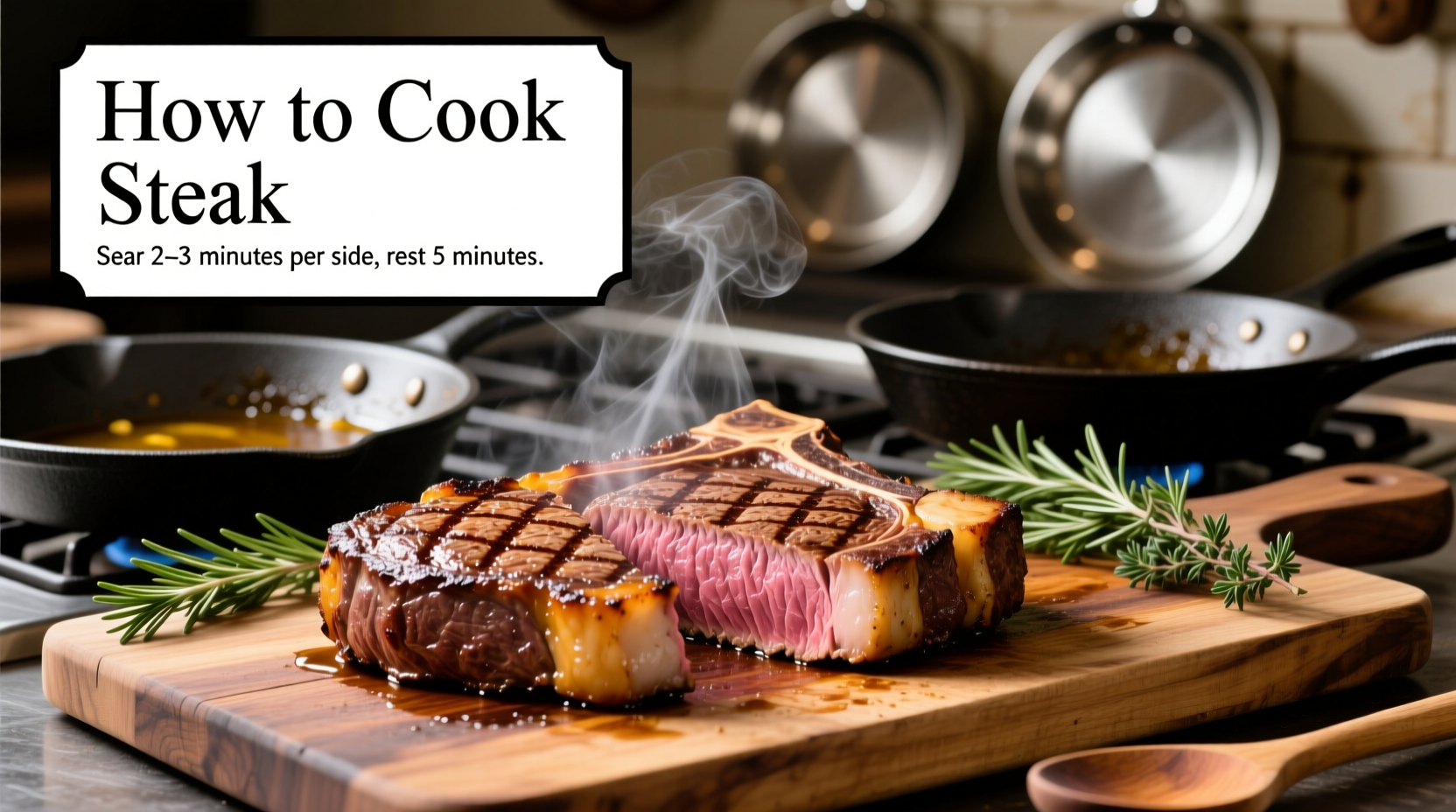The perfect way to cook steak involves bringing it to room temperature, seasoning properly, searing at high heat (400-450°F), reaching target internal temperatures (120°F for rare, 130°F for medium-rare), and resting for 5-10 minutes. Pan-searing followed by oven finishing delivers consistent restaurant-quality results at home.

Your Complete Roadmap to Perfect Steak
Mastering steak cooking transforms an expensive cut into a memorable meal or a disappointing waste. This guide delivers precisely what you need: no fluff, no complicated techniques, just proven methods that work whether you're using a cast-iron skillet, grill, or oven. You'll learn exactly when to flip, how to determine doneness without cutting, and why resting matters more than most home cooks realize.
Phase 1: Preparation Essentials
Skipping proper preparation guarantees inconsistent results. Follow these critical steps before heating your pan:
Selecting Your Cut
Not all steaks cook the same. Ribeye offers marbling that forgiving for beginners, while filet mignon requires precise timing due to its leanness. For first attempts, choose a 1.5-inch thick ribeye or New York strip with visible marbling.
Temperature Equalization
Remove steak from refrigerator 45-60 minutes before cooking. This critical step prevents:
- Cold center while exterior overcooks
- Gray bands forming inside the meat
- Inconsistent searing
Seasoning Strategy
Apply 1 teaspoon kosher salt per pound 40 minutes before cooking. This allows salt to penetrate rather than just sit on the surface. Add freshly ground black pepper just before cooking to prevent burning.
Phase 2: Cooking Methods Compared
Choose the method matching your equipment and desired outcome. Each technique follows the same fundamental principles but varies in execution.
| Method | Best For | Internal Temp Range | Time Required |
|---|---|---|---|
| Pan-Searing | Indoor cooking, thick cuts | 120-135°F | 8-12 minutes |
| Grilling | Outdoor cooking, smoky flavor | 120-135°F | 10-15 minutes |
| Reverse Sear | Thick cuts (2+ inches), precision | 115-125°F before sear | 45-60 minutes |
Pan-Searing: The Most Reliable Indoor Method
This two-stage technique delivers consistent results with minimal equipment:
- Heat 1 tablespoon high-smoke point oil (avocado or grapeseed) in cast-iron skillet over medium-high heat until shimmering (about 2 minutes)
- Place steak in pan, pressing gently to ensure full contact
- Cook undisturbed for 3-4 minutes until deep brown crust forms
- Flip and add 2 tablespoons butter, 2 crushed garlic cloves, and fresh thyme sprigs
- Tilt pan and spoon melted butter over steak continuously for 2-3 minutes
- Insert instant-read thermometer horizontally into thickest part
- Remove from heat at 5°F below target temperature (carryover cooking will raise temp)
Temperature Precision: The USDA Verified Guide
According to the USDA Food Safety and Inspection Service, steak reaches safe consumption at 145°F with 3-minute rest time. However, culinary professionals achieve optimal texture at lower temperatures:
- Rare: Remove at 120°F (final 125°F) - bright red center
- Medium-rare: Remove at 125°F (final 130°F) - warm red center
- Medium: Remove at 130°F (final 135°F) - warm pink center
- Medium-well: Remove at 140°F (final 145°F) - slightly pink center
Always verify with an instant-read thermometer rather than timing alone. Temperature accuracy matters more than cooking duration.
Phase 3: The Critical Resting Process
Resting isn't optional—it's essential for juicy results. Here's what happens during the resting timeline:
- 0-2 minutes: Surface temperature drops rapidly from 150°F to 130°F
- 3-5 minutes: Heat redistributes from exterior to center (carryover cooking)
- 6-10 minutes: Muscle fibers relax, reabsorbing juices that would otherwise bleed out
Cover loosely with foil to retain heat without steaming the crust. For 1-1.5 inch steaks, rest 5-7 minutes. For thicker cuts (2+ inches), rest 10 minutes. Cutting too soon releases up to 30% more juices according to American Meat Science Association research.
Phase 4: Troubleshooting Common Issues
Problem: Uneven Cooking
Solution: Use the "touch test" to check doneness. Compare the firmness of your steak to the fleshy part of your palm below the thumb:
- Rare: Thumb to index finger (soft)
- Medium-rare: Thumb to middle finger (slightly springy)
- Medium: Thumb to ring finger (firmer)
- Well-done: Thumb to pinky (very firm)
Problem: Burnt Exterior, Raw Interior
Solution: For thick cuts, use the reverse sear method. Bake at 275°F until internal temperature reaches 115°F, then sear for 60-90 seconds per side. This technique prevents the gray band that forms when high heat penetrates too quickly.
Problem: Lack of Crust Formation
Solution: Ensure your pan is properly preheated (water droplets should dance and evaporate immediately). Pat steak completely dry with paper towels before seasoning. Moisture on the surface prevents proper Maillard reaction.
Advanced Technique: Butter Basting for Flavor Depth
Professional chefs use butter basting to infuse additional flavor while cooking. During the final 2-3 minutes of cooking:
- Add 2 tablespoons unsalted butter, 2 smashed garlic cloves, and fresh herbs to the pan
- Tilt the pan 45 degrees, submerging the spoon in the melted butter
- Scoop butter repeatedly over the top surface of the steak
- Maintain this for 90 seconds, monitoring internal temperature
This technique creates a richer crust and infuses aromatic compounds without burning delicate ingredients.
When to Avoid Certain Methods
Understanding context boundaries prevents cooking disasters:
- Thin cuts (under 1 inch): Avoid reverse sear—cook entirely on stovetop
- Marinated steaks: Skip butter basting (sugar in marinade causes burning)
- Grilling in cold weather: Increase preheat time by 50% to compensate for heat loss
- Cast-iron limitations: Never use on glass-top stoves without proper protection











 浙公网安备
33010002000092号
浙公网安备
33010002000092号 浙B2-20120091-4
浙B2-20120091-4